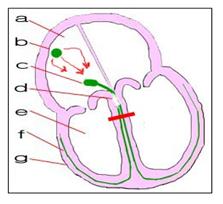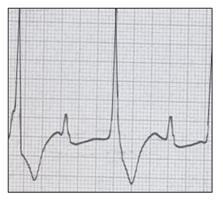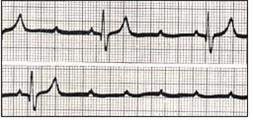방실 차단 부정맥(실방 차단 부정맥) Atrioventricular block arrhythmia (ventricular block arrhythmia)

그림 71. 3도 방실 차단 심전도
a-심방, b-동방 결절, c-방실 결절, d-히스 속, e- 심실, f-푸르키니에 망상섬유, g-심근
Copyright ⓒ 2013 John Sangwon Lee, MD., FAAP

그림 72. 3도 방실 차단성 부정맥의 심전도
Copyright ⓒ 2013 John Sangwon Lee, MD., FAAP
방실 차단 부정맥(심방 차단 부정맥)의 원인
-
심장 자극전도가 선천적 원인 또는 후천적 원인으로 차단될 때 심장이 불규칙하게 박동되어 생긴 부정맥을 방실 차단 부정맥이라 한다.
-
정상 심장 자극 전도는 심방 결절→방실 결절→히스 속 심장 자극 전도계의 좌우 다발 가지→퍼킨제(푸르키니에 망상섬유)를 통해서 이루어진다.
-
심장 자극이 전도되는 중 어떤 장애로 정상 심장 자극 전도가 차단되면 부정맥이 생기게 된다. 방실결절 전도가 차단되면 방실 차단 부정맥이 생길 수 있다.
-
방실 차단 부정맥은 정도에 따라
- 1도 방실 차단 부정맥,
- 2도 방실 차단 부정맥,
- 3도 방실 차단 부정맥으로 분류된다.
-
방실 차단 부정맥은 선천성 심장 기형이 있을 때나, 후천성 심장질환이 있을 때 생길 수 있다.
방실 차단 부정맥(실방 차단 부정맥)의 증상 징후
-
방실 차단 부정맥이 있어도 증상이 거의 없는 경우도 있다.
-
그렇지만 방실 차단 부정맥으로 갑자기 실신할 수 있다.
-
선천성 심장 기형에 의해서 방실 차단 부정맥이 생겼을 때는 선천성 심장 기형에서 오는 증상과 방실 차단 부정맥의 증상이 함께 나타난다.
-
현기증, 실신, 호흡곤란 등은 전형적인 방실 차단 부정맥의 증상이다.
방실 차단 부정맥(실방 차단 부정맥)의 진단 치료
-
병력, 증상 징후와 진찰소견 등을 종합하여 이 병이 의심되면 심전도, 가슴 X-선 사진 검사, 심 초음파 검사, 피검사 등으로 진단할 수 있다. 치료는 원인에 따라 한다.

그림 73. 방실 차단 부정맥 심전도
Copyright ⓒ 2013 John Sangwon Lee, MD., FAAP
Atrioventricular block arrhythmia (ventricular block arrhythmia) 방실 차단 부정맥(실방 차단 부정맥)

Figure 71. 3-degree atrioventricular block electrocardiogram a-atrium, b-eastern nodule, c-atrioventricular nodule, d-heather, e-ventricle, f-purkinie reticular fiber, g-myocardium Copyright ⓒ 2013 John Sangwon Lee, MD., FAAP

Figure 72. Electrocardiogram of 3-degree atrioventricular arrhythmia Copyright ⓒ 2013 John Sangwon Lee, MD., FAAP
Causes of atrioventricular arrhythmia (atrial block arrhythmia)
The arrhythmia caused by the heart beating irregularly when the heart impulse conduction is blocked due to a congenital or acquired cause is called an atrioventricular arrhythmia. Normal cardiac stimulation conduction is achieved through atrial nodules → atrioventricular nodules → left and right bundles of the heart stimulation conduction system in the heath → Perkinje (Purkinie reticular fibers). Arrhythmia occurs when normal cardiac stimulation is blocked due to some disorder during the conduction of cardiac stimulation. Blocked atrioventricular node conduction can lead to atrioventricular arrhythmia.
Atrioventricular arrhythmia depends on the severity First degree atrioventricular arrhythmia, Second degree atrioventricular arrhythmia, It is classified as a third degree atrioventricular arrhythmia.
Atrioventricular arrhythmia can occur when there is a congenital heart malformation or when you have acquired heart disease.
Symptoms signs of atrioventricular arrhythmia (ventricular block arrhythmia)
In some cases, atrioventricular arrhythmia has few symptoms. However, atrioventricular arrhythmia can cause sudden fainting. When atrioventricular arrhythmia is caused by congenital heart anomaly, symptoms of atrioventricular arrhythmia appear together with the symptoms of atrioventricular arrhythmia.
Dizziness, fainting, and difficulty breathing are typical symptoms of atrioventricular arrhythmia.
Diagnosis, treatment of atrioventricular arrhythmia (ventricular block arrhythmia)
If this disease is suspected by synthesizing the medical history, symptoms, and examination findings, it can be diagnosed by electrocardiography, chest X-ray examination, echocardiography, blood examination, etc. Treatment depends on the cause.

Figure 73. Atrioventricular arrhythmia electrocardiogram Copyright ⓒ 2013 John Sangwon Lee, MD., FAAP
출처 및 참조문헌
- www.drleepediatrics.com제11권. 소아청소년 심장 혈관계 질환
- www.drleepediatrics.com제7권 소아청소년 감염병
- Red book 29th-31st edition 2021
- Nelson Text Book of Pediatrics 19th — 21st Edition
- The Johns Hopkins Hospital, The Harriet Lane Handbook, 22nd edition
-
Childhood Emergencies in the Office, Hospital and Community, American Academy of Pediatrics
-
Emergency Medical Service for Children, By Ross Lab. May 1989. p.10
-
Emergency care, Harvey grant, and Robert Murray
-
Emergency Care Transportation of Sick and Injured American Academy of Orthopaedic Surgeons
-
Emergency Pediatrics A Guide to Ambulatory Care, Roger M. Barkin, Peter Rosen
-
Immediate care of the acutely ill and injured, Hugh E. Stephenson, Jr
-
The Critically Ill Child, Diagnosis and Management, Edited by Clement A. Smith
-
Emergency Medical Services for Children: The Role of the Primary Care Provider, America Academy of Pediatrics
-
Quick Reference To Pediatric Emergencies, Delmer J. Pascoe, M.D., Moses Grossman, M.D. with 26 contributors
-
Manual of Emergency Care
-
응급환자관리 정담미디어
-
소아가정간호백과–부모도 반의사가 되어야 한다, 이상원
-
Neonatal Resuscitation American heart Association
-
Neonatology Jeffrey J.Pomerance, C. Joan Richardson
-
Pediatric Resuscitation Pediatric Clinics of North America, Stephen M. Schexnayder, M.D.
-
Pediatric Critical Care, Pediatric Clinics of North America, James P. Orlowski, M.D.
-
Preparation for Birth. Beverly Savage and Dianna Smith
- Nelson Text Book of Pediatrics 19th Edition
-
Infectious disease of children, Saul Krugman, Samuel L Katz, Ann A. Gershon, Catherine Wilfert
-
The Harriet Lane Handbook 19th Edition
-
소아과학 대한교과서
-
제1권 소아청소년 응급의료 참조문헌과 출처
-
Other
Copyright ⓒ 2015 John Sangwon Lee, MD., FAAP
“부모도 반의사가 되어야 한다”-내용은 여러분들의 의사로부터 얻은 정보와 진료를 대신할 수 없습니다.
“The information contained in this publication should not be used as a substitute for the medical care and advice of your doctor. There may be variations in treatment that your doctor may recommend based on individual facts and circumstances. “Parental education is the best medicine.”